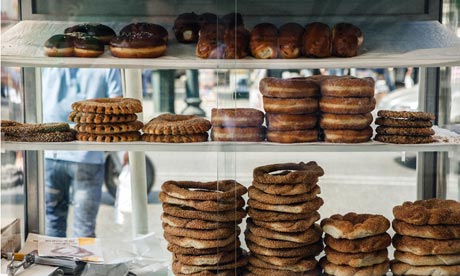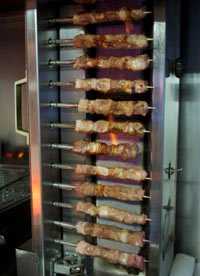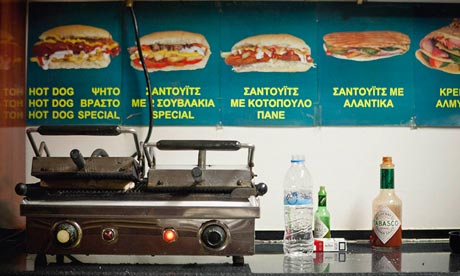Source: theguardian.com
With the first World Street Food Congress
kicking off in Singapore, the Culinary Backstreets network is
celebrating the best street food and stalls in the cities covered by its
bloggers, kicking off with Shanghai.

Da Hu Chun specialises in juicy pork buns. Photograph: UnTour Shanghai
Shengjianbao
A
Shanghai speciality,
shēngjiān mántou – or
shēngjiān bāo, as they're known everywhere else in
China
– are juicy pork buns wrapped in bread dough, then arranged in a flat,
oil-slicked wok in which the bottoms are fried till they are crispy.
Although shēngjiān mántou can be found on most street corners in the
morning, we're especially fond of the delicious misshapen buns at
Da Hu Chun
(11 Sichuan Nan Lu, near Yan'an Dong Lu). An officially recognised
Chinese Time-Honored Brand, Da Hu Chun has been splattering grease since
the 1930s and, nearly 80 years later, has six restaurants across
Shanghai. The venue's chefs use the rare "clear water" technique, frying
the pinched side of the dough face-up to create little Frankenstein
buns that might not be as photogenic as the more common "troubled water"
variety, but that have a thinner skin that gets extra crisp – and we'll
sacrifice good looks for better flavour any day.
• Original
location at 11 Sichuan Nan Lu, near Yan'an Dong Lu, +86 21 6330 8402.
Second location at 71 Yunnan Nan Lu, near Jinling Dong Lu, +86 21 6249
3683. Hours vary, but usually about 7.30am-8pm; Chinese menu only
Guotie
A popular morning snack that gets your arteries clogging early in the day,
guō tiē
translates literally as "pot stickers." Like their thicker-skinned
cousins, shengjianbao (above), they are first fried on the bottom to
create a crunchy foundation for the pork filling, then steamed with
water under a wooden lid to soften the dumpling skin and cook the meat.
You can find vendors hawking both shengjianbao and guotie out of the
same shallow wok, but for the best bite, head to the specialists:
Huji Potstickers.
They fire up their woks at 5.30am inside a narrow alleyway kitchen in
the former French Concession, usually selling out well before the
lunchtime rush. Packed in like an edible jigsaw puzzle, nearly 100
dumplings line the shallow wok, manned by a laconic cook who spins the
pot with a pair of greasy pliers, ensuring that each guotie base gets a
liberal swirl of oil and ends up a delicious golden brown. Be warned:
these greasy pork-filled bites come out sizzling, so take a small nibble
(or chopstick poke) and suck out all the juice before popping them
whole into your mouth.
• 209 Pu'an Lu, near Taicang Lu, no phone. Open 5.30-11am; Chinese menu only
Congyoubing
 Mr Wu at A Da Congyoubing. Photograph: UnTour Shanghai
Cōngyóubing
Mr Wu at A Da Congyoubing. Photograph: UnTour Shanghai
Cōngyóubing, or scallion oil pancakes – savoury golden
rounds slicked with lard, stuffed with salty pork and bright green
scallions, then pan-fried in standing oil – are a common breakfast treat
in Shanghai, but you haven't tried them until you've sampled the ones
from
A Da Congyoubing. The grizzled chef, Mr Wu, is one
of the few street vendors in town who can command a following that will
line up patiently for over an hour just for a bite of his edible wares.
He huddles over a scalding grill for up to nine hours a day – no easy
task, especially for a man who was born a hunchback. But without fail,
Mr Wu single-handedly churns out the best scallion oil pancakes in the
city six days a week, using a process he's perfected over the past 30
years. The secret is crisping them up at the end, which he does by
rolling back the slick griddle and placing them inside the makeshift
40-gallon barrel, where they are licked to a dark brown crisp by the
kerosene-fueled flames.
• Lane 159, back door of no 2 Maoming Lu, near Nanchang Lu, no phone. Open 5am-2pm, closed Wednesday; Chinese menu only
Shaokao
Head to any well-trafficked bar strip in Shanghai and you'll find plumes of smoke rising above the drunken revelry.
Shāokao is Chinese barbecue – and the perfect late-night snack. Hungry patrons pick and choose from tables laden with bamboo skewers (
chuànr)
threaded with a grocery store's worth of meat and vegetables, putting
their choices on a silver tray before handing it to the guys manning the
grill. They nestle the skewers into the narrow charcoal grill, painting
oil on to the kebabs and sprinkling their secret barbecue powder
(usually a combination of ground cumin, paprika, chili powder, red chili
flakes and Sichuan peppercorn) onto the grilled goods while wafting
handheld fans at the coals for a smoky finish.
Try the juicy lamb from Xinjiang province (
yángròu):
the skewer is pushed through two chunks of meat, then an unctuous cut
of fat before being capped off with two more chunks of meat – it's the
perfect flavour ratio for glistening meaty kebabs. Or opt for whole
yellow croaker fish skewered from tail to tongue (
huángyú).
Cruciferous veggies like cauliflower and lotus root hold up best to the
flames, but leek is another surprisingly tasty option, with its slender
green shoots adding an earthy flavour to the mélange.
Jianbing
Sometimes called Chinese crepes, flapjacks or burritos,
jiānbing
are served up streetside on flat griddles. Originally from Shandong
province, jianbing were invented almost two millennia ago – according to
legend – to fuel a wok-less army, who fought their way out of an ambush
after this simple but efficient meal. While the original version of
jianbing consisted of little more than flour mixed with water and cooked
on a flat surface over a blazing fire, today's are beefed up with a
scrambled egg cracked atop the millet flour pancake. Coriander, green
onions and pickled mustard tubers are sprinkled over the egg as it
cooks, adding a burst of green freshness. The pancake is folded in half,
then slathered in umami-laden soybean paste and spicy chilli flakes.
Add a deep-fried wonton wrapper – or sub in a
yóutiáo, or fried
dough stick, for extra crunch – and then watch as the pancake is
wrapped around all the ingredients and thrown into a plastic bag, making
for a great handwarmer on a cold winter's day, and the perfect
on-the-go meal for any season. Streetside jianbing slingers can be found
every few blocks in the morning, but after 11am it's darn near
impossible to find a vendor, except for one entrepreneurial woman who
caters to all-day jianbing cravings
outside the wet market on Wulumuqi Lu.

















